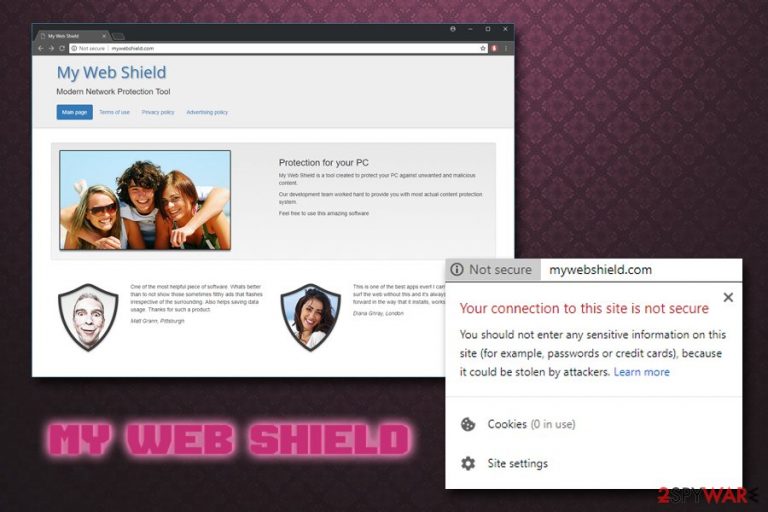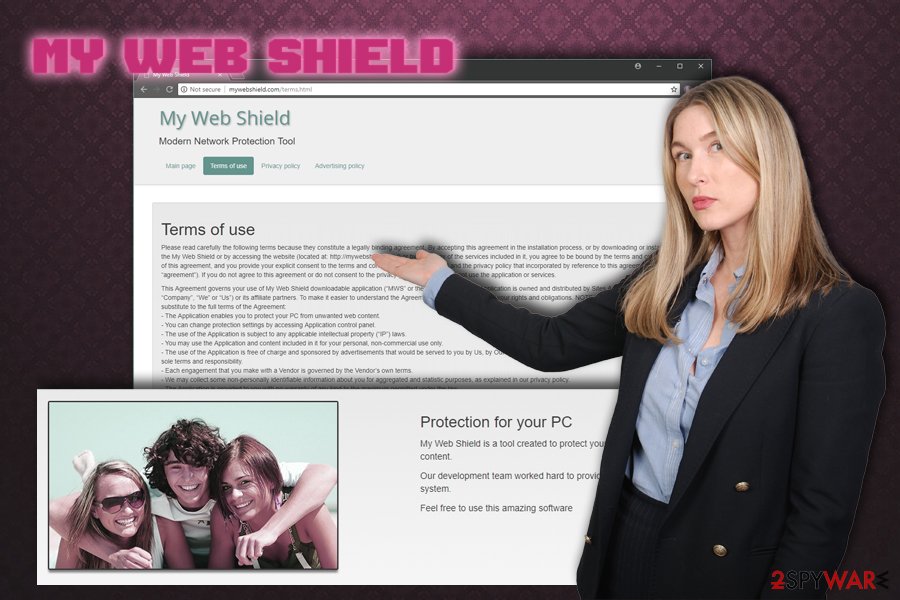My Web Shield ads (Removal Instructions) - updated Aug 2018
My Web Shield ads Removal Guide
What is My Web Shield ads?
My Web Shield – an adware program that promises to block you from visiting malicious sites

My Web Shield is a questionable application that is usually promoted via advertisements or is injected into users' computers via software bundling. Regardless of the installation technique, the app promises users to prevent them from visiting malicious websites, which could lure netizens to keep the program. Unfortunately, My Web Shield installation also has certain side effects. Users will soon notice annoying pop-ups, deals, offers, in-text links and various other forms of advertising popping on Google Chrome, Internet Explorer, Mozilla Firefox and other browsers, regardless of which website is visited.
| Summary | |
| Name | My Web Shield |
| Type | Adware |
| Distribution | Software bundling |
| Symptoms | Increased amount of advertisements and redirects |
| Compatible browsers | Google Chrome, Internet Explorer, Mozilla Firefox, Safari, Opera, etc. |
| Main dangers | Information leakage, potential malware infections, compromised browsers |
| Detection and elimination | Use FortectIntego for a quick solution or check our manual instructions below |
The application is considered to be adware,[1] and, while not malicious by its design (it does not corrupt or damage system files in any way), might cause users a lot of frustration. While they struggle to understand where the program came from, My Web Shield removal might be a problem as well, as adware is known to obfuscate its presence well – it usually does not provide the executable to uninstall the app, as well as hides under different names.
As soon as My Web Shield virus infiltrates the machine, it modifies certain settings on the PC, allowing it to perform several tasks. Its primary goal – to redirect users to sponsored websites that would generate revenue to adware creators. While browsing the internet, users might encounter ads marked as follows:
Pop-ups, auto-play video, and audio ads can appear on any website that is visited, regardless if it promotes sponsored content or not. Therefore, finding the correct information plagued by My Web Shield ads might become an impossible task.
Another worrisome feature of the potentially unwanted program is information tracking. Remember, that main goal of adware is selling products or services of developers' affiliates to you. Therefore, the My Web Shield adware employs various tracking technologies (like beacons, tracking cookies,[2] JavaScript and similar) to harvest all the non-personally identifiable information about you and created a virtual ID.

The purpose of such information tracking is to generate targeted ads. Thus, every time you visit a website which represents your favorite football team, the adware carefully records that and sends you an advertisement related to it. However, My Web Shield ads might be coming from phishing, fake or overpriced sites that would make you waste money on useless stuff.
There is no doubt that online security is necessary, but users should rely on legitimate tools to protect them online. If the PUP entered your machine without your knowledge, security experts[3] recommend using FortectIntego to remove My Web Shield ads from your computer. The scan will also eliminate all other dubious applications that could have gotten in while adware was present on your system.
Distribution methods of potentially unwanted programs
PUP developers use various tactics to get this nasty program on the users’ computers, but the most common one is called bundling. This marketing strategy is also acknowledged by beginning software creators who use it to spread the word about their product to make it popular. The sad news is that the well-known developers like Microsoft are using the same technique. While the installed programs might not be malicious, they can certainly cause users some trouble.
Therefore, we recommend you being extremely careful when downloading and installing new software from the internet, regardless of how acclaimed it is. You should never rush through installation steps and read Terms and Conditions properly. Most importantly, opt for Advanced/Custom installation instructions instead of Quick/Recommended ones. This will allow you to eliminate all the tick marks next to add-ons, browser extensions, optimization tools and other useless software before the installation is complete.
Finally, we urge you to stay away from suspicious ads and redirects. Adware can also be installed when browsing the internet, as adverts on certain websites might convince you of the legitimacy of certain apps. Do not fall for this trick, and research the app on Google.com, Bing.com, Yahoo.com or another reputable search engine.

Recommendations for My Web Shield removal
My Web Shield virus is a program that should not linger on your computer. Since it usually stays on the victims’ computers for quite some time, it is deep-rooted in the system, and its related components may be spread throughout the computer without any particular order making manual My Web Shield removal quite complicated.
Thus, it is useful to have professional antivirus software that could remove My Web Shield ads automatically. All you have to do is download one of the programs mentioned below and run a full system scan.
We should also inform you that there is other, alternative way to banish potentially unwanted programs from your PC – manual elimination. If you would like to try out this method, scroll down below where you will find detailed instructions.
You may remove virus damage with a help of FortectIntego. SpyHunter 5Combo Cleaner and Malwarebytes are recommended to detect potentially unwanted programs and viruses with all their files and registry entries that are related to them.
Getting rid of My Web Shield ads. Follow these steps
Uninstall from Windows
To eliminate My Web Shield ads from Windows, follow these steps:
Instructions for Windows 10/8 machines:
- Enter Control Panel into Windows search box and hit Enter or click on the search result.
- Under Programs, select Uninstall a program.

- From the list, find the entry of the suspicious program.
- Right-click on the application and select Uninstall.
- If User Account Control shows up, click Yes.
- Wait till uninstallation process is complete and click OK.

If you are Windows 7/XP user, proceed with the following instructions:
- Click on Windows Start > Control Panel located on the right pane (if you are Windows XP user, click on Add/Remove Programs).
- In Control Panel, select Programs > Uninstall a program.

- Pick the unwanted application by clicking on it once.
- At the top, click Uninstall/Change.
- In the confirmation prompt, pick Yes.
- Click OK once the removal process is finished.
Delete from macOS
Get rid of the PUP on macOS by following these guidelines:
Remove items from Applications folder:
- From the menu bar, select Go > Applications.
- In the Applications folder, look for all related entries.
- Click on the app and drag it to Trash (or right-click and pick Move to Trash)

To fully remove an unwanted app, you need to access Application Support, LaunchAgents, and LaunchDaemons folders and delete relevant files:
- Select Go > Go to Folder.
- Enter /Library/Application Support and click Go or press Enter.
- In the Application Support folder, look for any dubious entries and then delete them.
- Now enter /Library/LaunchAgents and /Library/LaunchDaemons folders the same way and terminate all the related .plist files.

Remove from Microsoft Edge
Delete unwanted extensions from MS Edge:
- Select Menu (three horizontal dots at the top-right of the browser window) and pick Extensions.
- From the list, pick the extension and click on the Gear icon.
- Click on Uninstall at the bottom.

Clear cookies and other browser data:
- Click on the Menu (three horizontal dots at the top-right of the browser window) and select Privacy & security.
- Under Clear browsing data, pick Choose what to clear.
- Select everything (apart from passwords, although you might want to include Media licenses as well, if applicable) and click on Clear.

Restore new tab and homepage settings:
- Click the menu icon and choose Settings.
- Then find On startup section.
- Click Disable if you found any suspicious domain.
Reset MS Edge if the above steps did not work:
- Press on Ctrl + Shift + Esc to open Task Manager.
- Click on More details arrow at the bottom of the window.
- Select Details tab.
- Now scroll down and locate every entry with Microsoft Edge name in it. Right-click on each of them and select End Task to stop MS Edge from running.

If this solution failed to help you, you need to use an advanced Edge reset method. Note that you need to backup your data before proceeding.
- Find the following folder on your computer: C:\\Users\\%username%\\AppData\\Local\\Packages\\Microsoft.MicrosoftEdge_8wekyb3d8bbwe.
- Press Ctrl + A on your keyboard to select all folders.
- Right-click on them and pick Delete

- Now right-click on the Start button and pick Windows PowerShell (Admin).
- When the new window opens, copy and paste the following command, and then press Enter:
Get-AppXPackage -AllUsers -Name Microsoft.MicrosoftEdge | Foreach {Add-AppxPackage -DisableDevelopmentMode -Register “$($_.InstallLocation)\\AppXManifest.xml” -Verbose

Instructions for Chromium-based Edge
Delete extensions from MS Edge (Chromium):
- Open Edge and click select Settings > Extensions.
- Delete unwanted extensions by clicking Remove.

Clear cache and site data:
- Click on Menu and go to Settings.
- Select Privacy, search and services.
- Under Clear browsing data, pick Choose what to clear.
- Under Time range, pick All time.
- Select Clear now.

Reset Chromium-based MS Edge:
- Click on Menu and select Settings.
- On the left side, pick Reset settings.
- Select Restore settings to their default values.
- Confirm with Reset.

Remove from Mozilla Firefox (FF)
Remove dangerous extensions:
- Open Mozilla Firefox browser and click on the Menu (three horizontal lines at the top-right of the window).
- Select Add-ons.
- In here, select unwanted plugin and click Remove.

Reset the homepage:
- Click three horizontal lines at the top right corner to open the menu.
- Choose Options.
- Under Home options, enter your preferred site that will open every time you newly open the Mozilla Firefox.
Clear cookies and site data:
- Click Menu and pick Settings.
- Go to Privacy & Security section.
- Scroll down to locate Cookies and Site Data.
- Click on Clear Data…
- Select Cookies and Site Data, as well as Cached Web Content and press Clear.

Reset Mozilla Firefox
If clearing the browser as explained above did not help, reset Mozilla Firefox:
- Open Mozilla Firefox browser and click the Menu.
- Go to Help and then choose Troubleshooting Information.

- Under Give Firefox a tune up section, click on Refresh Firefox…
- Once the pop-up shows up, confirm the action by pressing on Refresh Firefox.

Remove from Google Chrome
You need to reset Google Chrome to its previous state:
Delete malicious extensions from Google Chrome:
- Open Google Chrome, click on the Menu (three vertical dots at the top-right corner) and select More tools > Extensions.
- In the newly opened window, you will see all the installed extensions. Uninstall all the suspicious plugins that might be related to the unwanted program by clicking Remove.

Clear cache and web data from Chrome:
- Click on Menu and pick Settings.
- Under Privacy and security, select Clear browsing data.
- Select Browsing history, Cookies and other site data, as well as Cached images and files.
- Click Clear data.

Change your homepage:
- Click menu and choose Settings.
- Look for a suspicious site in the On startup section.
- Click on Open a specific or set of pages and click on three dots to find the Remove option.
Reset Google Chrome:
If the previous methods did not help you, reset Google Chrome to eliminate all the unwanted components:
- Click on Menu and select Settings.
- In the Settings, scroll down and click Advanced.
- Scroll down and locate Reset and clean up section.
- Now click Restore settings to their original defaults.
- Confirm with Reset settings.

Delete from Safari
Remove unwanted extensions from Safari:
- Click Safari > Preferences…
- In the new window, pick Extensions.
- Select the unwanted extension and select Uninstall.

Clear cookies and other website data from Safari:
- Click Safari > Clear History…
- From the drop-down menu under Clear, pick all history.
- Confirm with Clear History.

Reset Safari if the above-mentioned steps did not help you:
- Click Safari > Preferences…
- Go to Advanced tab.
- Tick the Show Develop menu in menu bar.
- From the menu bar, click Develop, and then select Empty Caches.

After uninstalling this potentially unwanted program (PUP) and fixing each of your web browsers, we recommend you to scan your PC system with a reputable anti-spyware. This will help you to get rid of My Web Shield registry traces and will also identify related parasites or possible malware infections on your computer. For that you can use our top-rated malware remover: FortectIntego, SpyHunter 5Combo Cleaner or Malwarebytes.
How to prevent from getting adware
Stream videos without limitations, no matter where you are
There are multiple parties that could find out almost anything about you by checking your online activity. While this is highly unlikely, advertisers and tech companies are constantly tracking you online. The first step to privacy should be a secure browser that focuses on tracker reduction to a minimum.
Even if you employ a secure browser, you will not be able to access websites that are restricted due to local government laws or other reasons. In other words, you may not be able to stream Disney+ or US-based Netflix in some countries. To bypass these restrictions, you can employ a powerful Private Internet Access VPN, which provides dedicated servers for torrenting and streaming, not slowing you down in the process.
Data backups are important – recover your lost files
Ransomware is one of the biggest threats to personal data. Once it is executed on a machine, it launches a sophisticated encryption algorithm that locks all your files, although it does not destroy them. The most common misconception is that anti-malware software can return files to their previous states. This is not true, however, and data remains locked after the malicious payload is deleted.
While regular data backups are the only secure method to recover your files after a ransomware attack, tools such as Data Recovery Pro can also be effective and restore at least some of your lost data.
- ^ Adware. Trend Micro. Malware researchers.
- ^ Everything You Need to Know about Tracking Cookies (Computer cookies). SaferVPN. Safety Blog.
- ^ Senzavirus. Senzavirus. Cybersecurity news and articles.
